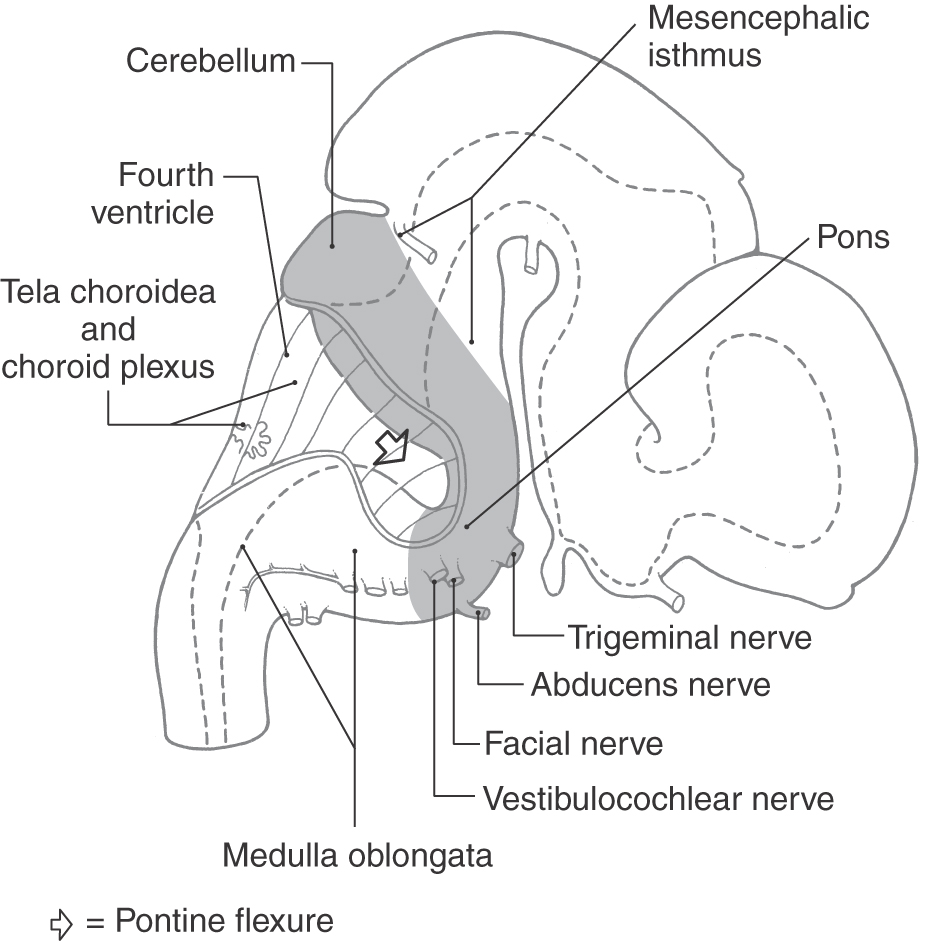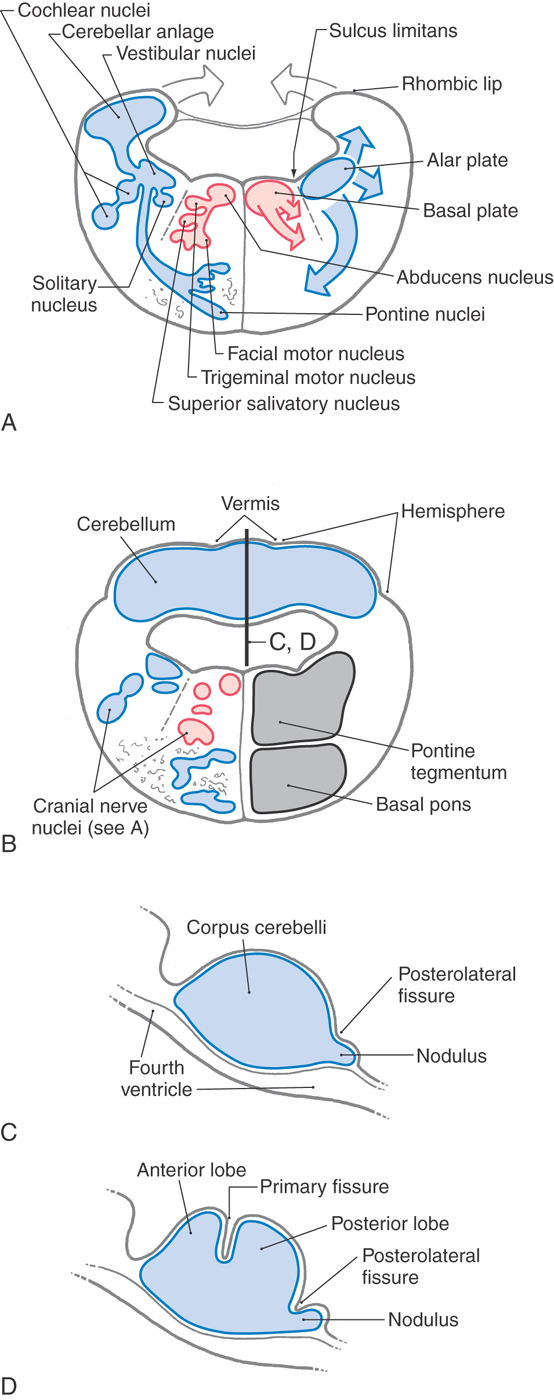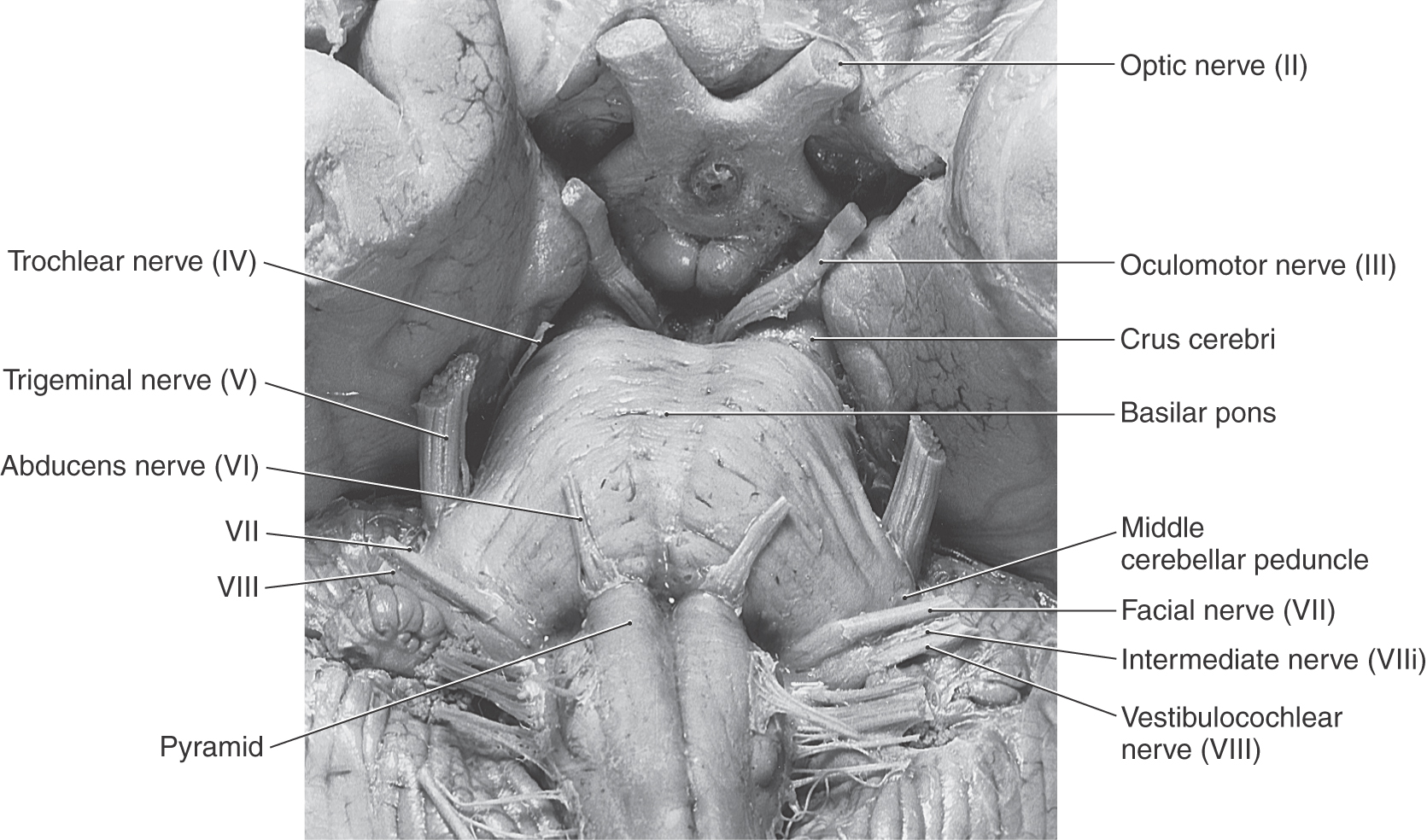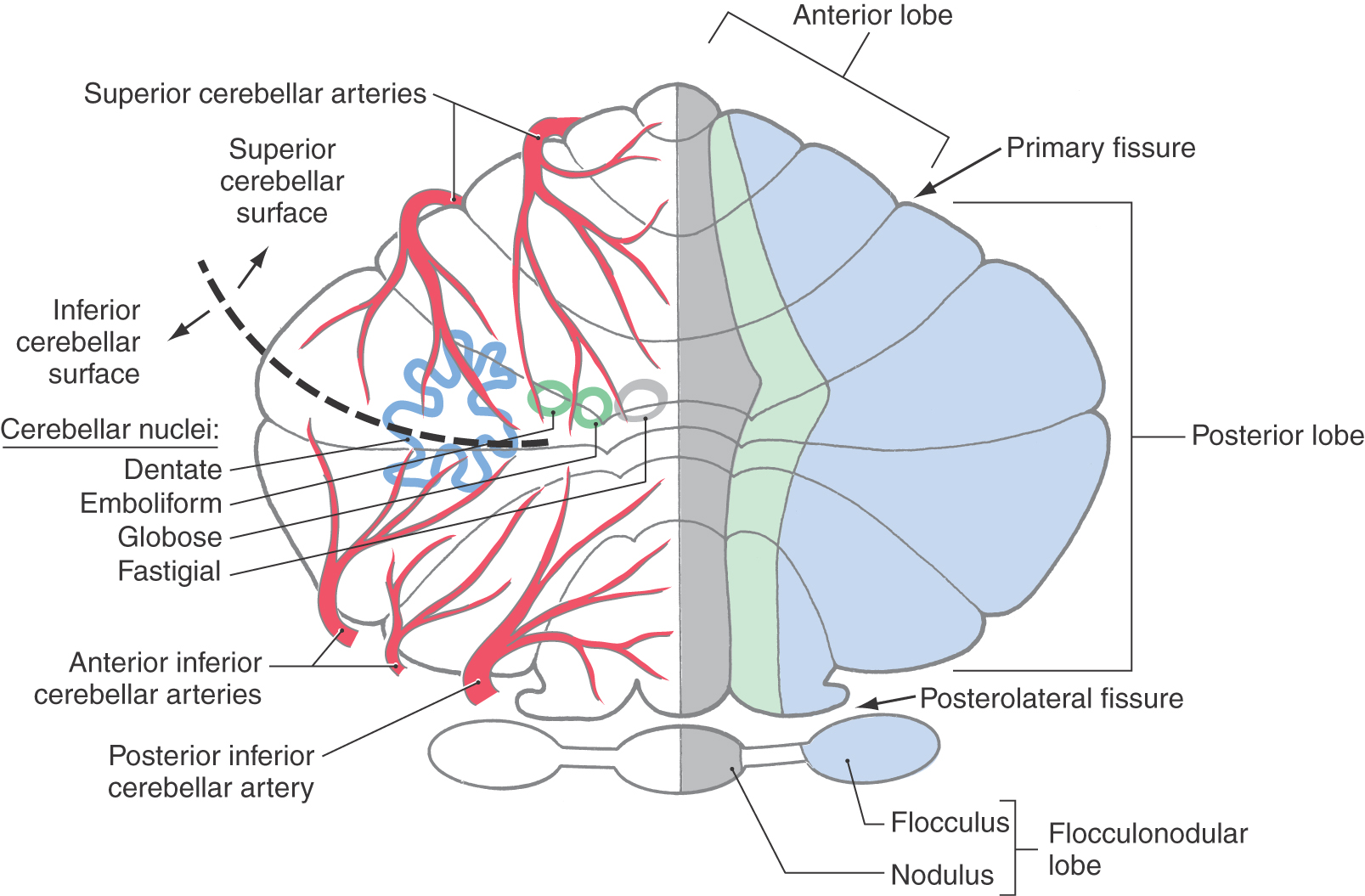Chapter 12
The Pons and Cerebellum
Vasculature of the Pons and Cerebellum
Summary of Descending Pathways
Internal Vasculature of the Pons
Vascular Syndromes of the Pons
The metencephalon consists of the pons and cerebellum. The pons is the middle segment of the brainstem, the caudal part being the medulla and the rostral portion being the midbrain. Although comprising only about 1.3% of the brain by weight, the pons has many important functions. The motor and sensory nuclei and the exit points of cranial nerves V to VIII are associated with the pons. The cerebellum is not part of the brainstem but rather is considered a suprasegmental structure because it is located superior to the brainstem. The cerebellum is comparatively large, comprising about 10.5% of the total brain weight. Functionally, it is part of the motor system. The blood supply to the pons and cerebellum arises from branches of the basilar and cerebellar arteries.
DEVELOPMENT
The pons and cerebellum are considered together in this chapter because they arise from the same region of the developing neural tube. The metencephalon extends from the pontine flexure to the mesencephalic isthmus (Fig. 12-1). At this level, the cavity of the neural tube is enlarged, forming the parts of the fourth ventricle associated with the pons and cerebellum.
Figure 12-1. Lateral view of the brain at about 7 weeks of gestational age. The pons and cerebellum are highlighted.
Basal and Alar Plates
The basal and alar plates of the brainstem extend from the medulla rostrally into the developing pons. The cranial nerve motor nuclei found in the pons (trigeminal, abducens, facial, and superior salivatory) originate from the basal plate and are located medial to the sulcus limitans (Fig. 12-2A, B). The functional components of these motor neurons include somatic efferent (SE) (trigeminal, facial, and abducens) and visceral efferent (VE) (superior salivatory).
The cranial nerve sensory nuclei located in the pons include portions of the trigeminal and vestibulocochlear nuclei and the rostral tip of the solitary nucleus. These nuclei originate from the alar plate and are found lateral to the sulcus limitans (Fig. 12-2A, B). Their functional components are somatic afferent (SA) for the trigeminal nucleus and vestibular and cochlear nuclei and visceral afferent (VA) for the solitary nucleus. This recognizes the fact that taste may be generally regarded as a special sense. The portion of the posterior pons that contains these motor and sensory nuclei as well as the reticular formation and several ascending and descending tracts is the pontine tegmentum (Fig. 12-2B).
The anterior area of the developing pons is invaded by large numbers of descending cortical fibers. Although some will terminate here, others pass through to more caudal targets. Immature alar plate neurons also migrate into this anterior pontine region to form the basilar pontine nuclei. These nuclei, their axons, and the descending fibers passing to and through this area collectively form the basilar pons (Fig. 12-2B).
Cerebellum
The cerebellum develops from the rhombic lips of the pontine alar plates. These lips expand posteromedially toward each other until they meet at the midline and fuse to form the cerebellar plate (Fig. 12-2A, B), which is the rudiment of the cerebellum. As development progresses, the cerebellum is divided by transverse fissures into lobes and lobules. The first of these fissures to appear is the posterolateral fissure, which separates the flocculonodular lobe caudally from the corpus cerebelli rostrally. The primary fissure, the second to appear, divides the corpus cerebelli into the anterior and posterior lobes (Fig. 12-2B-D). Internal changes, such as development of the cerebellar cortex and nuclei, take place concurrently with these external events.
EXTERNAL FEATURES
Basilar Pons
The portion of the brainstem lying between the midbrain rostrally and the medulla caudally is the pons (pons, Latin for “bridge”). Anteriorly and laterally (Fig. 12-3), the pons consists of a massive bundle of transversely oriented fibers that enter the cerebellum as the middle cerebellar peduncle (brachium pontis). The exit of the trigeminal nerve marks the transition from the basilar pons, which is anterior to the trigeminal root, to the middle cerebellar peduncle, which lies posterior to the exit of the trigeminal nerve (Figs. 12-3 and 12-4). Rostrally, the large axonal bundles forming the crus cerebri of the midbrain extend into the basilar pons. Caudally, some of these axons emerge to form the pyramids of the medulla (Fig. 12-4A).
Figure 12-3. Anterior (ventral) view of the brainstem with emphasis on the pons.
The cranial nerves that emerge from the pons are the trigeminal (V), abducens (VI), facial (VII), and vestibulocochlear (VIII). The trigeminal nerve exits laterally and is composed of a large sensory root (the portio major) and a small motor root (the portio minor) (Fig. 12-4A). The portion of the trigeminal nerve that traverses the subarachnoid space between the pons and the trigeminal ganglion forms a landmark that is visible on magnetic resonance imaging at this level (Fig. 12-4B). The abducens, facial, and vestibulocochlear nerves emerge in medial to lateral sequence along the pons-medulla junction (Fig. 12-3). Although cranial nerve VII is commonly called the facial nerve, it is actually composed of two roots, the facial nerve (SE fibers) and the intermediate nerve (VA, VE, and SA fibers). The vestibulocochlear nerve (SA fibers) emerges posterolaterally and, with the facial and intermediate nerves and labyrinthine artery, occupies the internal acoustic meatus.
Rhomboid Fossa of the Pons
The rhomboid fossa forms the floor of the fourth ventricle. Its caudal portion is located in the medulla, and its larger, more rostral area is in the pons. The posterior surface of the pontine tegmentum, which forms the floor of the fourth ventricle, is visible only when the cerebellum is detached from the brainstem (Fig. 12-5). This part of the ventricular floor is characterized by the facial colliculus located between the median fissure and the superior fovea of the sulcus limitans and by the vestibular area located lateral to the sulcus limitans. The facial colliculus is formed by the underlying abducens nucleus and internal genu of the facial nerve, and the vestibular area marks the location of the vestibular nuclei. The brachium pontis and the brachium conjunctivum form the lateral walls of the fourth ventricle in the pons; the roof is formed by the anterior medullary velum, by a small part of the cerebellum, and by a portion of the tela choroidea (Fig. 12-6).
Figure 12-5. Pontine part of the fourth ventricle and rhomboid fossa. Also see Figure 10-4 for further details of the rhomboid fossa.
Figure 12-6. Sagittal view of the brainstem (with emphasis on the pons) and cerebellum.
Cerebellum
The cerebellum is located posterior to the brainstem and fills much of the posterior fossa. It is attached to the brainstem by three pairs of cerebellar peduncles (superior, middle, and inferior). In sagittal section, the human cerebellum appears wedge shaped (Fig. 12-6), with its superior surface apposed to the tentorium cerebelli and its inferior surface curving toward the foramen magnum.
The cerebellum consists of anterior, posterior, and flocculonodular lobes; each lobe, in turn, is composed of lobules (Figs. 12-6 and 12-7). Lobes and lobules are separated from each other by fissures. Lobules are made up of yet smaller folds of cerebellar cortex called folia (singular, folium). Cerebellar folia, lobules, and lobes can often be followed across the midline from one side of the cerebellum to the other.
Each cerebellar lobe (and lobule) is also divided into rostrocaudally oriented regions of cortex commonly called the vermis (medial), intermediate (paravermis), and hemisphere (lateral) zones (Fig. 12-7). The vermal zone is approximately 1.0 cm across at its widest point. The hemisphere is expansive in the human cerebellum and is separated from the vermis by the intermediate zone.
Four cerebellar nuclei are located in the white matter core of each hemisphere. From medial to lateral, they are the fastigial, globose, emboliform, and dentate nuclei (Fig. 12-7). These cells receive input from branches of cerebellar afferent fibers and from Purkinje cells located in the cerebellar cortex. In turn, axons of cerebellar nuclear cells provide the main output signals of the cerebellum. The structure, function, and connections of the cerebellar cortex and nuclei are considered in greater detail in Chapter 27.














